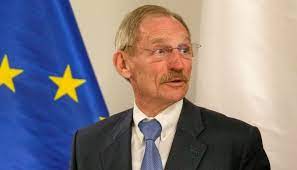Khaled Abou Zahr
This week, the presidents of Czechia, Poland, Hungary and Slovakia found common ground on supporting Ukraine, despite their differing views on military assistance. While Czechia and Poland have been strong supporters of Ukraine, Hungary has refused to supply weapons and has accused Kyiv of violating the rights of its ethnic Hungarian minority. Slovakia, while it has ended its military aid, remains committed to offering humanitarian assistance. Despite these differences, the leaders agreed on the importance of Ukraine’s success and the need to provide various forms of support.
Their unanimous consensus opposes allowing Russia to prevail in the war in Ukraine. This meeting and its declarations signal a more decisive approach by Central and Eastern European countries toward defense matters. These countries, collectively known as the Visegrad Group, seek to further their integration with the EU while promoting cooperation in military, economic, cultural and energy-related areas. The four states are all members of the Bucharest Nine, the EU and NATO. The war in Ukraine has given this group a broader outreach and, despite its members’ differing views, it has been broadly aligned on the military side, especially thanks to NATO.
Central and Eastern European countries are increasingly vocal and assertive in influencing the future of the continent’s defense. If the Europeans consider that Russia is their greatest military threat, then these countries are the first line of defense. This is why, earlier this year, a coalition of Eastern European countries led by Poland and Estonia urged NATO members to increase their defense spending benchmark from 2 percent to 2.5 percent or even 3 percent of gross domestic product. Poland’s previous government, in particular, had been pushing for this increase and it committed to spending 4 percent of its GDP on the military, making it NATO’s biggest spender in terms of percentage of GDP. Moreover, Hungary, Romania and Slovakia also meet or surpass the recommended minimum of 2 percent of GDP. This surge in defense spending is a response to the war in Ukraine and represents a shift in the center of security power in Europe toward the east.
These countries are also seeking to modernize their militaries and are dependent on foreign suppliers for their military buildup. Their increased spending has implications for NATO’s strategic focus and could lead to Eastern European states gaining a stronger voice on defense matters within NATO and the EU. However, concerns exist about how these enlarged defense budgets will be spent and whether European security concerns will become purely continental, primarily focused on countering threats from Russia. Despite the push for greater European self-reliance in defense, the need for US power remains acknowledged and Eastern European countries are generally more accepting of Washington’s role as a security guarantor. Poland, in particular, is seeking a permanent American military presence on its soil. There are underlying issues on how Europe analyzes threats and it is very clear that these countries do not feel that their Western European neighbors are listening or are even concerned about the threats they have determined.
This shows a two-tiered European defense hierarchy. The western one with France and Germany, which follow their own paths, and the central and eastern countries that feel left as the first line of defense without real support. In short, there is more talk than action. One of the clear pieces of evidence of the war in Ukraine is that Europeans have been underspending and underinvesting in their military capacity. Declarations, for now, are showing a will to go back to a more traditional war positioning, with tanks and heavy artillery. However, one key point is the supply chain and sheer military industrial capacity. And here, in reality, there is a lack of contracts. There are encouraging signs and funds that are being set up to create this development, both at the national and European levels. Yet, the untapped capacity of developing an industrial output throughout Central and Eastern Europe and mutualizing efforts and resources does not seem to be at the top of the agenda. This is why these countries understandably feel more fulfilled with the transatlantic alliance than with the European Defence Agency. In order to put things into perspective, the budget of the latter is only €43.5 million ($47.5 million) and was increased by 15 percent this year. This is not much to support the development of capacity and new initiatives.
There is no doubt that the EU needs to stay strongly anchored within the transatlantic alliance. However, it also needs to put forward a clear and consistent long-term vision that supports all its members in developing stronger military capacity, as well as ensuring their protection. It is very clear that this dual sovereignty – of Europe-wide and national level – is a major obstacle to this future development. This becomes especially true as the EU faces diverging views on key issues such as migration and border control. It is also clear that Central and Eastern European countries will not stay silent and, even if they have different views on the war in Ukraine and how to face or mitigate the Russian risk, the last Visegrad Group meeting showed they are increasingly in alignment about having their voices heard at the highest level of European decision-making when it comes to military affairs. In the meantime, they are forging stronger links with the US, which is in turn empowering positive capacity-building developments for these countries. One thing is clear: divisions and a two-tiered European defense are a bigger threat to Europe’s security than Russia.







